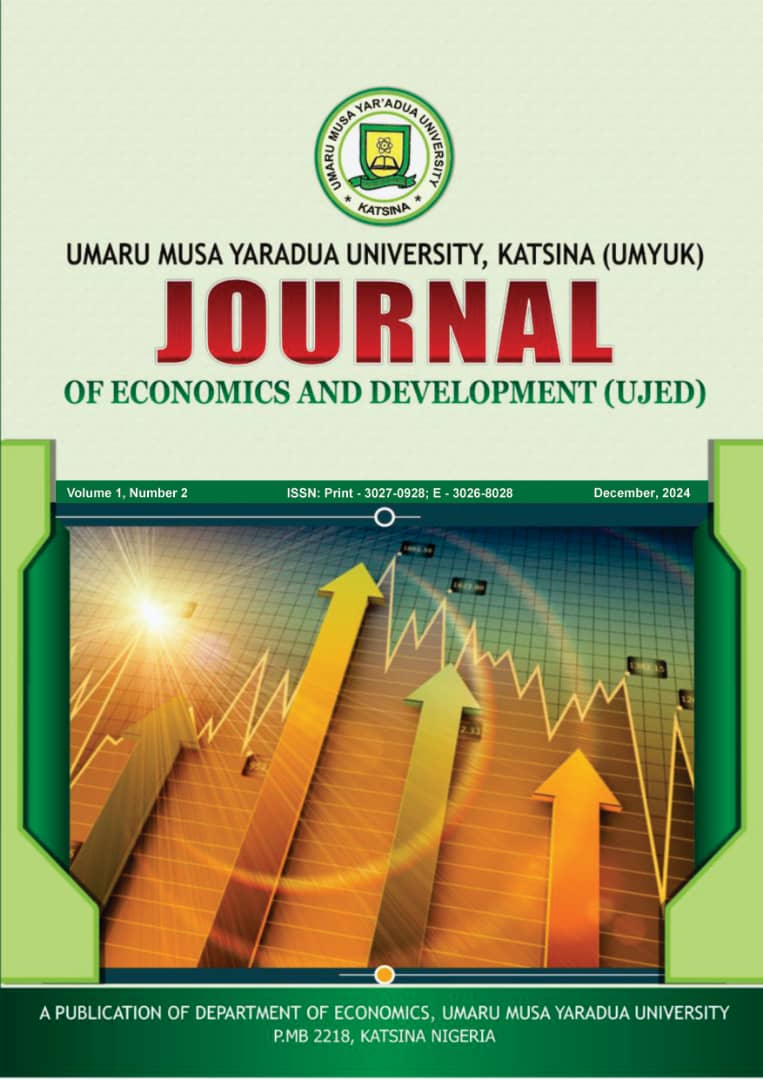EFFECT OF FOREIGN DIRECT INVESTMENT AND VALUE ADDED TAX ON MANUFACTURING SECTOR PERFORMANCEIN NIGERIA
Main Article Content
Abstract
This study investigates the extent to which foreign direct investment, value
added tax, inflation, and exchange rate affect manufacturing sector
performance in Nigeria for the period 1981-2022. The study deployed the
Autoregressive Distributed Lag (ARDL) bounds test approach and Toda
and Yamamoto Granger causality tests. The findings of the study
unraveled a negative and statistically significant effect of foreign direct
investment on manufacturing value added in the long run. Similarly, the
study documented a negative and statistically significant effect of value
added tax on manufacturing value added, confirming its potential to
hinder manufacturing growth. However, inflation exhibits a counter
intuitive positive and significant impact on manufacturing value added in
both the long and short run, warranting further exploration. Also, the
study discovered that exchange rate stimulates manufacturing sector
performance in both short and long run. The outcome of Toda-Yamamoto
causality analysis reveals the presence of unidirectional causality from
direct investment to manufacturing sector performance without feedback.
However, the two-way causality relationship has been observed between
value added tax and manufacturing sector performance. Thus, the study
recommends that government should review value added tax structure to
minimize its negative impact. Secondly, government should develop a
comprehensive foreign direct investment strategy focused on technology
transfer and knowledge spillovers. Implementing sound macroeconomic
policies to control inflation and maintain a stable environment. And
finally, maintaining a flexible exchange rate policy with targeted
interventions.
Article Details

This work is licensed under a Creative Commons Attribution-NonCommercial 4.0 International License.
References
References
Ajudua, E. I., &Ojima, D. J. P. (2016).The Determinants of Capacity Utilization in the Nigerian Manufacturing Sector.International Journal of Innovative Finance and Economics Research, 4(1), 1–12. Retrieved from www.seahipaj.org
Appiah, M., Li, F., &Korankye, B. (2019). Foreign investment & growth in emerging economies: panel ARDL analysis. Journal of Economics, Business, & Accountancy Ventura, 22(2), 274-282.
Central Bank of Nigeria. (2022). Annual Statistical Bulletin. Retrieved from https://www.cbn.gov.ng
Central Bank of Nigeria.(2020). Public Sector Statistical Bulletin.Publication of the CBN.
Dagim E. (2020) The Impact of Macroeconomic Factors on Manufacturing Sector Value Added in Ethiopia: An Application of Bounds Testing Approach to Cointegration. Journal of Economics, Business, and Accountancy Ventura. 23(1), 96 – 107.
Dantama, Y. U., Abdullahi, Y. Z., & Inuwa, N. (2012). Energy consumption-economic growth nexus in Nigeria: An empirical assessment based on ARDL bound test approach. European Scientific Journal, 8(12), 141-157.
Deloitte Nigeria (2019). Nigerian Government proposes 50% increase in vat rate. Retrieved from http://blog.deloitte.com.ng/nigerian-government-proposes-50-percentincrease-in-vat-rate/
Emmanuel, O. O. &Saliu, W. (2017).Hazards of Manufacturing Sector and Economic Growth in Nigeria..International Journal of Social Sciences, Humanities and Education (IJSSHE).1(1).
Federal Inland Revenue Service. (2019). VAT in Nigeria. Retrieved from https://www.firs.gov.ng
Granger, C. (1988) Causality, Cointegration and Control. Journal of Economic Dynamics and Control, 12(2-3), 551-559.
Harris, H. &Sollies, R. (2003).Applied time series modelling and Forecasting.Wiley, West Sussex.
Idoko, C. U., & Taiga, U. U. (2018). Effect of Foreign Direct Investment (FDI) On Manufacturing Output in Nigeria (1981 – 2016). Advances in Social Sciences Research Journal, 5(5) 181-197.
Manoj K. M. (2018).Determinants of Manufacturing Sector Growth in Ethiopia.Amity Journal of Management Amity Business School. 6(2), pg 1 – 12
Manufacturers Association of Nigeria. (2018). Manufacturing sector experience. Modeling of the Nigerian Experience.European Journal of Business and Management.8(17). 49 – 59.
Nasiru, I., & Usman, H. M. (2012). Health expenditure and economic growth nexus: An ARDL approach for the case of Nigeria. Journal of Research in National Development, 10(3), 95-100.
National Bureau of Statistic (NBS) (2019). Annualized Sectoral Reports in Nigeria, Abuja Federal Printing Press, 879p.
National Bureau of Statistics (NBS). (2023). Nigerian Manufacturing Sector: SUMMARY
National Bureau of Statistics. (2022). Nigerian Gross Domestic Product Report. Retrieved from https://www.nigerianstat.gov.ng
Nigeria, Journal of Research in Business and Management. 9(1), 42 – 49.
Obikwelu A. (2018) The Impact of Human Capital Development on the Manufacturing Sector in Nigeria. Researchgate.https://www.researchgate.net/publication/337172083
Okoli, M. N. &Afolayan, O. T. (2015). Impact of value added tax on the Nigerian economy. International Journal of Economics, Commerce and Management, 3(10), 1-11.
Okoli, M.N. &Afolayan, S. M. (2015) “Correlation between value added tax and revenue in Nigeria: An ECM model” Research Journal of Finance and Accounting. 6(6) 230-238.
Okoli, T. T. &Agu, O. C. (2005). Foreign direct investment flow and manufacturing sector performance inNigeria. International Journal of Economics, Commerce and Management, 3(7), 412 – 428.
Okoli, T. T., &Agu, O. C. (2015). Foreign direct investment flow and manufacturing sector performance in Nigeria. International Journal of Economics, Commerce and Management, 3(7), 428-513.
Ologunagbe O. (2023, July 27). Nigeria’s manufacturing sector growth hits three-year low in Q2. BusinessDay NG.
Pesaran, M.H. & Shin, Y., (1995). An Autoregressive Distributed Lag Modelling Approach to Cointegration Analysis. Cambridge Working Papers in Economics 9514, Faculty of Economics, University of Cambridge.
Pesaran, M.H., Shin, Y., & Smith, R.J. (2001) Bounds Testing Approaches to the Analysis of Level Relationships. Journal of Applied Econometrics, 16, 289-326.
Sakanko, M. A., Manomi, J. N., Ijoko, A., &Audu, U. A. (2022). Do Tax Policies in Nigeria Have Similar Implications for the Manufacturing Sector Output. Etikonomi, 21(2), 269– 280. https://doi.org/10.15408/etk.v2i2.25118.
Sokunle, R. O., Chase, J. M., & Harper, A. (2016).The Determinants of Manufacturing Growth Sector Growth in sub-Saharan Africa.Research in Business and Economics, 12(2), 29 - 40.
United Nations Industrial Development Organisation (UNIDO) (2011). Industrial Development OrganisationReport 2011.
World Bank (2021), World Development Indicators. Online database.
World Development Indicators (WDI) (2023). World development indicators. Washington, D. C.: World Bank.
